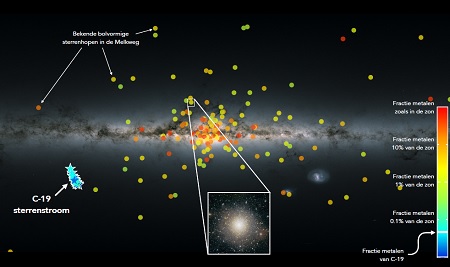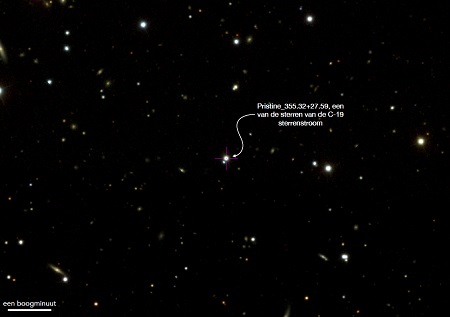Astronomers discover extremely metal-poor star stream in Milky Way
An international team of researchers including Else Starkenburg from the University of Groningen discovered the remnants of a star cluster whose stars share a uniquely low fraction of heavy elements. As successive generations of stars enrich the medium with heavy elements, this cluster must have been formed from very early generations of stars and provides a remarkable relic from a time when the very first stellar structures were assembling. It was not known that star clusters with such pristine stars existed — some theories even hypothesized they could not form at all, others that they would have all vanished by now — which makes this a key discovery for our understanding of how stars form in the early Universe.

Exciting discovery
To study the first stellar structures to form in the universe, astronomers can look at the most distant galaxies, observed as they were a long time ago, in their infancy. Alternatively, one can study the oldest structures in our own galaxy the Milky Way in great detail, an approach that is called “Galactic Archeology”. The vast majority of the stars that surround us were, like the Sun, formed in our Galaxy. However, a small fraction of the Milky Way's stars, favorably found in its outskirts, were brought in from smaller galaxies that gave their stars and stellar clusters to the Galaxy. The discovered cluster was brought in through such a process, but has been shedding its stars as it travels around the Galaxy as a result of tides, leaving a “stream” of stars on the sky.
“This exciting discovery illustrates the power of bringing together astronomers from across the world to share their enthusiasm and expertise”, says Else Starkenburg from the University of Groningen, co-author on the study. “Our international team unveiled the remarkable stellar cluster structure thanks to the combination of data from the Gaia spacecraft combined with observations from multiple ground-based telescopes”.

Surprising
To start, the team of researchers explored the unprecedentedly detailed map of the location and movement of stars gathered by the Gaia spacecraft, launched by the European Space Agency in 2013, with a novel algorithm to isolate the rare groupings of stars moving in concert. One of the structures discovered in this way is a new candidate stellar stream that the team called “C-19”. In parallel, the Pristine survey, conducted at the Canada-France-Hawaii Telescope in Hawaii, had been mapping the sky to systematically measure the fraction of heavy elements in millions of stars. When combined, these two studies revealed the surprising news that C-19 contains stars with an extremely low heavy element fraction.
Follow-up observations with the Gemini North Telescope in Hawaii and Gran Telescopio Canarias in La Palma revealed a more detailed picture of the heavy elements within these stars. They confirmed the stellar cluster nature of the disrupted object as well as the exceptionally low levels of heavy elements present in its stars: as low as 0.04% of that observed in our Sun and well below any other known structure in the universe.

Remnant
“This remnant from ancient times opens a direct and unique window into the early epochs of star formation in the universe and the build-up of stellar structures in these very early times”, explains Nicolas Martin, the lead-author on the study from Strasbourg Observatory in France. “Our continuously improving maps of the Milky Way from the Gaia mission and the Pristine survey will help improve the discovery of such exceptional grouping of stars as precious fossils from ancient times."
Text: press release NOVA
Reference: Nicolas F. Martin, Kim A. Venn, David S. Aguado, Else Starkenburg, Jonay I. Gonzalez Hernandez, Rodrigo A. Ibata, Piercarlo Bonifacio, Elisabetta Caffau, Federico Sestito, Anke Arentsen, Carlos Allende Prieto, Raymond G. Carlberg, Sebastien Fabbro, Morgan Fouesneau, Vanessa Hill, Pascale Jablonka, Georges Kordopatis, Carmela Lardo, Khyati Malhan, Lyudmila I. Mashonkina, AlanW. McConnachie, Julio F. Navarro, Ruben Sanchez Janssen, Guillaume F. Thomas, Zhen Yuan, Alessio Mucciarelli: A stellar stream remnant of a globular cluster below the metallicity floor. Nature, 6 January 2022
| Last modified: | 07 February 2025 12.07 p.m. |
More news
-
06 May 2025
Overcoming grid congestion: ‘Making better use of what we already have’
Grid congestion poses a major problem. There is little to no capacity to connect new households and businesses to the power grid and it risks halting the energy transition. Michele Cucuzzella, Associate Professor of Energy Systems & Nonlinear...
-
29 April 2025
Impact | Rubber recycling
In the coming weeks the nominees for the Ben Feringa Impact Award 2025 will introduce themselves and their impactful research or project. This week: Francesco Picchioni on his innovative way to recycle rubber.
-
29 April 2025
Impact | Improving Human-AI Decision-Making in healthcare
In the coming weeks the nominees for the Ben Feringa Impact Award 2025 will introduce themselves and their impactful research or project. This week: Andra Cristiana Minculescu on her research project on Human-AI Decision-Making in healthcare.

